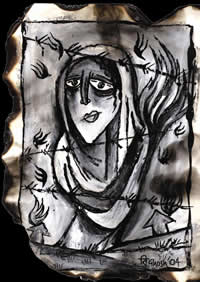
In October I wrote a piece about Sikhs and the Occupy Wall Street movement, stating, “I haven’t seen one other person who was easily identifiable as a Sikh. I’m sure other Sikhs have come through at different times, but to be sure, this is no significant Sikh presence.” I am glad to report that this has most definitely changed. I see Singhs and Kaurs at Zuccotti Park aka Liberty Square almost every time I am down there (which is quite often!). In fact, one day last week, there were six turbans in Liberty Square at one time. Needless to say, I was pretty excited, and proud.

"Occupy Yoga" at Liberty Square
In my last post, I made an argument for why Sikhs should be supportive of the Occupy Together movements from a Sikh philosophical perspective, discussing the Khalsa revolution’s “plebian mission,” as Jagjit Singh calls it, and our Gurus’ calls to stand with the poor, the “lowest of the low.”
This time I want to focus less on the ideology and more on the process of Occupy Wall Street, on what is actually happening there.
The primary decision-making body at Occupy Wall Street (and most of the other Occupy movements) is the General Assembly, which is a large gathering run by consensus process (technically modified consensus where a 9/10 vote is needed to pass a proposal if consensus cannot be reached). In NYC’s Occupy Wall Street movement, we have just adopted an additional consensus-based model for decision-making called a spokes council, where each working group or caucus will have a “spoke” in the large wheel of the movement, and each group will have to rotate its spoke for each meeting to ensure collectivity and prevent hierarchies.
When I met Sonny, I felt that his story demanded to be told. I was moved by his willingness to share difficult stories about how racism, xenophobia, and islamophobia impact him in a very daily and intimate ways. But more importantly, I was inspired by how he had turned this hardship into a motivation to fight for social justice for all people. I was welcomed with incredible warmth, and inspired by the Sikh traditions seeing the divine in all people, and fighting for equality. – Christina Antonakos-Wallace, Producer and Director of Article of Faith
To continue a discussion about bullying and bias-based harassment that seems to be appearing both here on The Langar Hall and also within langar halls across the nation, we wanted to take the time to highlight an inspiring documentary which discusses this very issue. Article of Faith is a short film, directed and produced by Christina Antonakos-Wallace, portraying one Sikh activist, Sonny Singh, who organizes New York City Sikh youth to combat harassment in their schools. Sonny shares his own, very personal experience with bullying recognizing how incredibly important it is for us to openly dialogue about these issues, so that other children who are experience similar challenges do not feel like they are alone.
Co-blogged by Sundari and Ajaib Kaur
How many young Sikh women do you know who are looking to meet their Sardar? And how many young Sikh men do you know who are looking to meet their Sardarni?
know who are looking to meet their Sardarni?
Lots? We hear you. But how can we make these two groups meet?
We decided to write a post on this topic for many different reasons. It’s clear that there is little space elsewhere to talk about how young Sikhs can meet each other, with the potential of pursuing something beyond a friendship.
Gasp! Are we actually admitting this? After a few dialogues with friends and families, we decided that we may as well start breaking the ice here on the West Coast. Over the last few years, SikhNet has been hosting “Gursikh Speed Meetings”, in cities such as New York, Boston, and Toronto. It is nice to see that the organizers has decided to bring this successful event to the West Coast, in our beloved City of Angels. These events give young, single Sikhs between the ages of 25-40 a chance to meet fellow single-and-ready-to-mingle like minded Sikhs in a communal safe space. This concept may feel familiar, because it is. The ‘speed meeting’ is a popular spin-off of an American cultured speed-dating event; having an even number of men and women participants, and rotating through getting a brief chance to connect with everyone in the room. It seems like a lot of work, but based on our feedback from some past participants, it is fairly enjoyable. The best part: if you do not click with someone mutually, you do not need to face them again. Contact information is only shared if both parties have expressed interest in each other. Fool proof for both ladies and gents!
Over this past weekend there was an article published in the Los Angeles Times of the experiences of Sikh women and maintaining kesh. This article addresses the journey and relationship with kesh, looking at societal pressures as well as a personal journey, and in this case, it happened to be my journey. The article idea was born out of a series of conversations I had with a reporter with the LA Times. I would also like to reiterate that this article is not about me as a representative of any Sikh organization I am part of.
Most of the feedback I have received has been complimentary, though some has been accusatory and judgmental. For all the commentary: Thank you for time, the words, and the emotions—whether I agree with it or not. My major concern, however, does not come from the extremely personal nature of the story you read, it comes from the fact that I felt misrepresented, and the issue highlighted was misrepresented. The last 48 hours or so I have been thinking about why, and that is what I would like to share.
My major concern is that the entire concept of hair removal is framed around men and marriage. This is problematic. Whereas the overall idea of double-standards concerning men and women is not a new one—I do not believe that there is only one person, or gender to blame. Perhaps it is what manifests as the topical problem, but the issues around hair removal and Sikh women are not, and should not be limited to this scope. My journey and struggles with my kesh seem to be conveniently minimized to be about men. The androcentric way that the issue of hair removal solely exists in a space with men and marriage is demeaning and incorrect as a reflection of my personal journey.
Following in the footsteps of great Sikh marathon runners like Fauja Singh, a young Sikh Ph.D. student named Simran Singh is currently training to run the largest marathon in the world — the New York City Marathon. And he’s running for a good cause. Simran is working with Team in Training and raising money for the Leukemia & Lymphoma Society. This is probably blogworthy in and of itself, but here’s what is extra exciting: Simran was selected by the NYC Marathon as one of just six featured runners this year!

Simran is already representing our community well in the public spotlight as one of the featured runners, but we can all help him get selected as the grand prize winner, meaning more positive representation and mainstream media attention for a turban-wearing Sikh. Hopefully Simran’s presence will help break down stereotypes and barriers (not to mention support cancer research).
Here’s what we can do to support Simran: Go to the ING Featured Runner’s Page, click “View Featured Runners,” and then you can vote for Simran once a day until the contest ends on November 4th. The runner with the most votes wins.
Good luck Simran!
Guest blogged by Navjot Kaur
Usually, I can take quite a lot before something unsettles me. Today, my pressure cooker was whistling.
When you think things can’t get much worse, they have a way of doing just that. When it rains, it pours, right? As I went to pick up my son at the end of his second day in Kindergarten, he appeared at the exit door with his patka almost off his head. I thought to myself, they probably had Gym class. But that wasn’t the case. I was quickly informed that another Kindergartener had pulled my son’s patka off his head while he sat on the carpet. I almost cried but didn’t. I felt angry but held it together for my son’s sake. I questioned whether it had been an action of curiosity? I hoped that the response would be positive but it was not. Bullying, in Kindergarten.
 Yes, my son looks different in many ways. He has his visible faith-identity and he also has his deaf identity. He’s smaller than his peers and he has some special challenges but his personality is like the sunshine. Its rays can trickle into even the darkest cracks and brighten up your day. I would not allow this incident to darken his future school days.
Yes, my son looks different in many ways. He has his visible faith-identity and he also has his deaf identity. He’s smaller than his peers and he has some special challenges but his personality is like the sunshine. Its rays can trickle into even the darkest cracks and brighten up your day. I would not allow this incident to darken his future school days.
We came home and once we had cuddled, I reassured him when he asked, “You’re going to tell [boy’s name] to say sorry to me?” I went into another room and cried. I’m not sure why I felt so defeated for that tiny moment but I did. Nevertheless, after talking to my sister, who works for a non-profit organization lobbying for change on such issues, I gained my strength and prepared next steps.
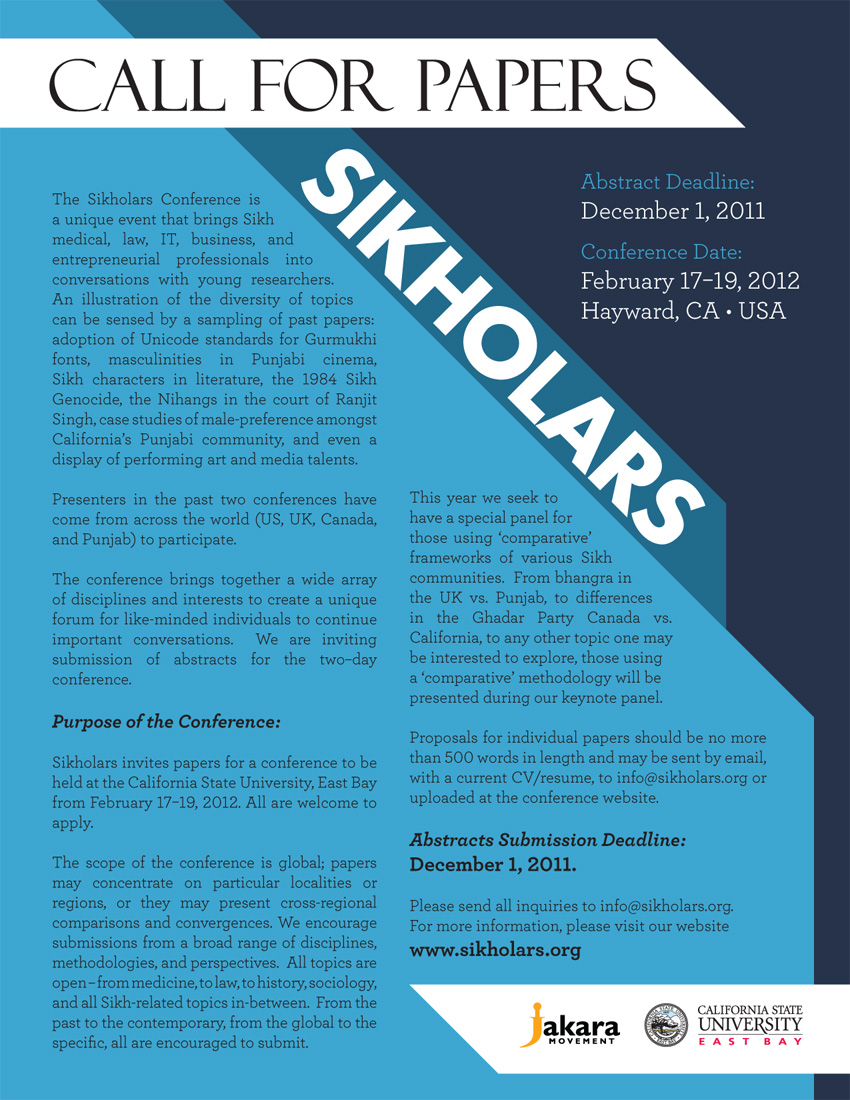 For the past two years, the Jakara Movement has created a forum for budding scholars and researchers, working on various projects Sikh, to come together, share, and challenge each one another.
For the past two years, the Jakara Movement has created a forum for budding scholars and researchers, working on various projects Sikh, to come together, share, and challenge each one another.
Over this period, it has become an extremely popular venue for community members, activists, and researchers to come together to engage on relevant issues. From Khalistan to Unix Coding, from sex-selective abortion to diasporic literature, from Nihangs in the court of Ranjit Singh to the historiography of Sikh studies, from Sikh sculpture and architecture to representations of masculinity in Punjabi films, from ecology of pre-Green Revolution Punjab to excerpts from a new book on Sikhs in Surrey to an amazing thabla-jazz infusion display, to even previews of newly-released movies with Sikh themes – there will be something that captivates and challenges you over the weekend. Please see previous abstracts from conferences 2010 and 2011 for more details.
By now I imagine most of you have heard about Occupy Wall Street in New York City and the growing “Occupy”  movement all over the country. Inspired by the mass uprisings of the Arab Spring, the movement is uniting under the banner, “We are the 99%”, in its protest of unprecedented economic inequality and Wall Street and corporate power and influence in the United States.
movement all over the country. Inspired by the mass uprisings of the Arab Spring, the movement is uniting under the banner, “We are the 99%”, in its protest of unprecedented economic inequality and Wall Street and corporate power and influence in the United States.
The official declaration of #OccupyWallStreet, released last week (as a working document), states:
As one people, united, we acknowledge the reality: that the future of the human race requires the cooperation of its members; that our system must protect our rights, and upon corruption of that system, it is up to the individuals to protect their own rights, and those of their neighbors; that a democratic government derives its just power from the people, but corporations do not seek consent to extract wealth from the people and the Earth; and that no true democracy is attainable when the process is determined by economic power. We come to you at a time when corporations, which place profit over people, self-interest over justice, and oppression over equality, run our governments. We have peaceably assembled here, as is our right, to let these facts be known.
The mainstream media coverage of the protest, now in its 18th consecutive day, has largely downplayed its significance or remained silent all together. Some in the movement, thus, raised $12,000 on Kickstarter in 3 days (now over $40K) and published 50,000 copies of the “Occupied Wall Street Journal,” grassroots media at its best. This says a lot about what is going on at Liberty Square (what protesters call the park they are occupying). People, many with little background in activism, are taking matters into their own hands, and building a democratic movement against corporate tyranny.
I have been participating in the growing protests regularly for the last week, and generally feel inspired and hopeful about what is happening in downtown Manhattan, despite some frustrations, some of which Sepia Mutiny just blogged about today. My time at Liberty Square–sometimes spent attending the nightly General Assemblies (where decisions are made by consensus, not unlike the Sikh Sarbat Khalsa process), sometimes participating in marches, sometimes playing a musical instrument–leaves me thinking about how this movement relates to Sikhs and Sikhi.
Last week the US military officially ended “Don’t Ask Don’t Tell” (DADT) after President Obama signed a repeal of the 18-year-old anti-gay policy last December. Gay, lesbian, and bisexual service members (note the absence of transgender people, who are still not allowed to serve openly) and advocates of gay rights have been celebrating the repeal as a civil rights victory.
The day the repeal went into effect, President Obama stated:
Patriotic Americans in uniform will no longer have to lie about who they are in order to serve the country they love. Our armed forces will no longer lose the extraordinary skills and combat experience of so many gay and lesbian service members. And today, as Commander in Chief, I want those who were discharged under this law to know that your country deeply values your service.
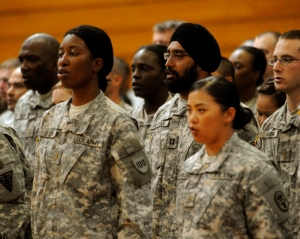
Captain Tejdeep Rattan at his graduation from the US Army basic training
This issue hits close to home for the US Sikh community, since the Pentagon’s uniform policy has not allowed Sikhs to serve with their kesh and dastaar since 1981. Similar to DADT, this is blatant discrimination and is an unacceptable policy for any employer, especially the federal government, which sets a powerful precedent for the rest of society.
Just as rights advocates have been fighting to end DADT for years (and finally succeeded), Sikhs launched a “Right to Serve” campaign in 2009, led by the Sikh Coalition and a Sikh doctor and dentist who were told by the Army to cut their hair when they report for basic training. The impressive efforts of Sikh cadets fighting for their rights and the tireless work of their advocates have resulted in the Army granting accommodations to three Sikhs, who are now serving with their turbans and unshorn hair in tact. The overall policy of the military nevertheless remains discriminatory.
Each year, SikhNet hosts an online youth film festival – to cultivate interest from Sikh filmmakers from around the globe. The online film festival is an excellent way for individuals to dialogue about issues affecting us personally and as a community. One of the films, titled Khalsa Has No Gender, is made by a group of young teen-aged Sikh women living in England and the goal of the film is to address gender [in]equality within our community. The film was striking to me for several reasons. Firstly, that these young women chose to use the medium of film to discuss this very important issue and secondly, that the concept of gender discrimination and inequality is prevalent in the conscience of very young Sikhs – Sikhs who are perhaps even 3rd and 4th generational living in the disapora.
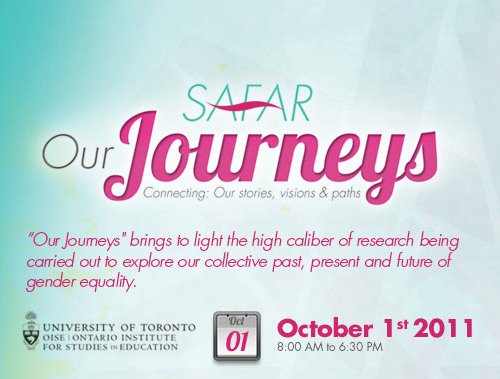 While on one hand it’s disheartening to acknowledge that perhaps change is slower than we have hoped it to be (displayed by the film), there is – on the other hand – reason to be optimistic. In just over a week, scholars and community members from across the globe are gathering in Toronto for the very first Sikh Feminist Conference, “Our Journeys”, hosted by the Sikh Feminist Research Institute (SAFAR).
While on one hand it’s disheartening to acknowledge that perhaps change is slower than we have hoped it to be (displayed by the film), there is – on the other hand – reason to be optimistic. In just over a week, scholars and community members from across the globe are gathering in Toronto for the very first Sikh Feminist Conference, “Our Journeys”, hosted by the Sikh Feminist Research Institute (SAFAR).
[Our Journeys is] an opportunity for scholars and community members alike to openly connect, converse and engage in a dialogue and critical thinking about gender related issues that demand to be voiced, and heard, in order to be addressed.
The line up of topics and speakers is remarkable. The keynote speaker, Professor Nikky-Guninder Kaur Singh is well known for introducing the term “Sikh feminism” and will share a Panel with Geetanjali Singh Chanda and Mallika Kaur to explore how Sikh feminism is defined, its origins, the present-day reality and how it can be an impetus for social change.
Guest blogged by Naujawani Sardar
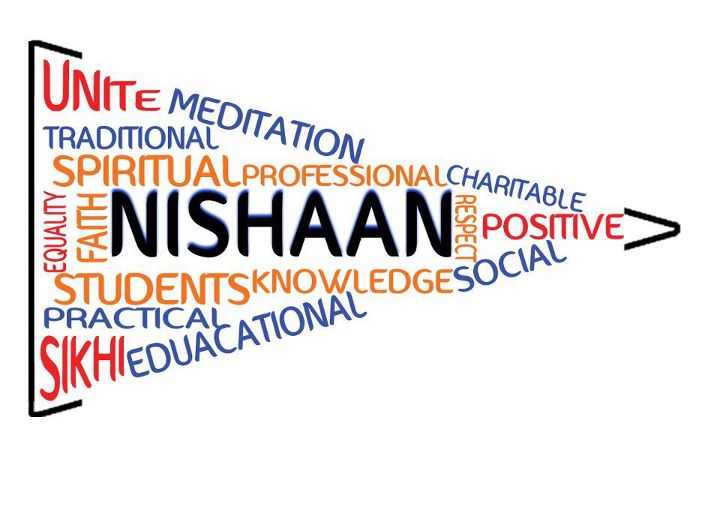 There has been a lot of talk about the SGPC elections recently, even over on our blog. And it got me thinking about a whole range of things from ‘selection vs. election’ to Sikh bodies outside of Punjab. My life in Sikh circles has been positively fascinating for over two decades now, but one of the things I have found most difficult to deal with has been the tension that arises around Sikh representative bodies. Before you stop reading, I’m not going to write about the SGPC – although what I’m writing about could quite easily fit the world of any organisation that represents Sikhs, and specifically those who have had to face false accusations.
There has been a lot of talk about the SGPC elections recently, even over on our blog. And it got me thinking about a whole range of things from ‘selection vs. election’ to Sikh bodies outside of Punjab. My life in Sikh circles has been positively fascinating for over two decades now, but one of the things I have found most difficult to deal with has been the tension that arises around Sikh representative bodies. Before you stop reading, I’m not going to write about the SGPC – although what I’m writing about could quite easily fit the world of any organisation that represents Sikhs, and specifically those who have had to face false accusations.
“Nishaan is a new organisation consisting of university Sikh Societies across London and the South East of England. It is created on the principle of ‘for the students by the students’.”
That is taken directly from the biography of ‘Nishaan‘ – a body of university students at institutions in London who have been collaborating and working closely together for the last year. In actual fact some amongst this group of students and this movement itself began in earnest four years ago when one particular University Sikh society at Imperial College London established an annual meal and gathering of Sikh socs from around the capital; they called the event ‘Collaborations’. Following that, students looked to ‘collaborate’ more often, but in reality it didn’t work efficiently because communication was poor, organisation was overly dependent on single individuals and the age-old division of jatha-affiliation reared its head.
The daily news program Democracy Now has long been a trusted source of information and analysis for progressives in the US and around the world. Their coverage of the attacks of 9/11/01 and the aftermath has been crucial for so many of us. You can check out an impressive and thorough timeline of their post-9/11 coverage here.
On today’s broadcast, Democracy Now correspondent Jaisal Noor highlighted the plight of the Sikh American community after 9/11, which you can see below.

As the 10th anniversary of the 9/11 attacks on the World Trade Center and Pentagon approaches, I am filled with a whole  mess of thoughts and emotions. 9/11 was a turning point in the United States–and the world–in so many ways. I need not explain what it has meant for us Sikhs in the United States and beyond, but in the coming days and weeks we will try to highlight some of the important initiatives taking place in commemoration of the 10th anniversary that go beyond jingoistic patriotism and provide opportunities for reflection, dialogue, and moving toward healing and justice.
mess of thoughts and emotions. 9/11 was a turning point in the United States–and the world–in so many ways. I need not explain what it has meant for us Sikhs in the United States and beyond, but in the coming days and weeks we will try to highlight some of the important initiatives taking place in commemoration of the 10th anniversary that go beyond jingoistic patriotism and provide opportunities for reflection, dialogue, and moving toward healing and justice.
Today, I was pleasantly surprised to read a compelling, heartfelt column in the Huffington Post about post-9/11 torture practices by the US government — written by a Sikh. In the piece, Satpal Singh, of the World Sikh Council, states:
I must shed the tears that I have been holding back for seven years. It was 1 a.m. on April 29, 2004, and I could not sleep. The beacon that I had always looked up to had gone dark.
I had just heard about Abu Ghraib. It shook my faith in my country’s ability to uphold its values. Admittedly, it takes the strongest of the strong to face the evil that we were facing, and the highest of morality to face it without losing one’s own morality. But now, even America, the mightiest of the mighty, the champion of human rights, the unquestioned upholder of morality, had blinked in the face of evil. The terror had seized us. Faced with evil, we had abandoned our own values.
One of the many tragedies of the American post-9/11 era is that torture has become a routine tactic in the treatment of terrorism suspects. While these policies began during the Bush Administration (see a new report by Human Rights Watch on the subject here), there seems to be much less protest of their continuation under Obama’s presidency. While Obama promised to closed down the infamous Guantanamo detention center during his presidential campaign, it still remains as do Bush/Cheney era interrogation tactics.
Embracing my new role as a proud Chacha, I recently bought some Sikhi-related children’s books for my niece for her first birthday. I was especially excited about this new book and CD of Sikh nursery rhymes called Ik Chota Bacha. The book/CD is a great way to teach basic Sikh values to kids and help develop their Punjabi skills (all the nursery rhymes are in Punjabi) in a fun way. I played the CD for my niece on the daily when I was visiting for her birthday, and by the end of the week, the whole family was singing along to some of the catchy (and rather cheesy) tunes. (See a full review of the book here.)
My excitement about the release Ik Chota Bacha quickly became muddied with disappointment and frustration once I saw the book’s illustrations. Every single Sikh child and adult depicted in the book looks WHITE. I don’t just mean they’re all fair-skinned on the spectrum of brownness. I mean peachy, rosey-cheeked, white.
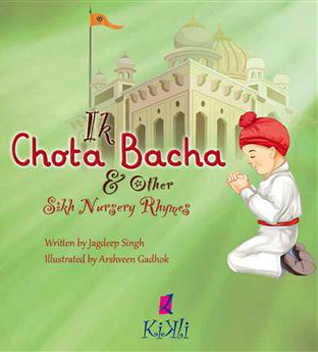
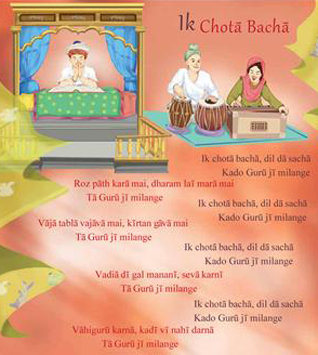
 If you were looking to attend a Sikh retreat a decade ago, you may have had a difficult time finding one. Thankfully, this is no longer the case. We are now fortunate enough to have a plethora of retreats and conferences to participate in. These retreats offer Sikhs an opportunity to cultivate our spirituality in hopes of moving us forward on our journey, whatever stage we may be at.
If you were looking to attend a Sikh retreat a decade ago, you may have had a difficult time finding one. Thankfully, this is no longer the case. We are now fortunate enough to have a plethora of retreats and conferences to participate in. These retreats offer Sikhs an opportunity to cultivate our spirituality in hopes of moving us forward on our journey, whatever stage we may be at.
For the past several Septembers, I’ve packed up my things and traveled to Santa Cruz to attend Saanjh. Each year, i come back feeling fulfilled and rejuvinated. This year’s Saanjh will be particularly special – the organizers will be offering Amrit Sanchaar for those individuals who are ready to make this commitment. A note from the organizers states:
Photo Credit: Gurumustuk Singh
We are proud to announce that there will be a ‘Khandey Baatey di Paul’/ ‘Amrit Sanchaar’ at Saanjh this year. Khande di Pahul or Amrit is the most spiritually significant event in a Sikh’s life. When one decides to partake in Amrit, she or he makes a commitment to walk the Sikh spiritual path. Amrit is the beginning of a journey, not the end–it’s akin to admission into a school to study a subject matter seriously, not graduation. For those of you who are looking to make the commitment, may we offer Saanjh as the venue for your commitment ceremony.
The retreat will bring together young Sikhs from across North America (and sometimes beyond!) to participate and engage in Sikhi. Whether or not we are ready to take Amrit – Saanjh offers us a unique opportunity to observe and learn about this very special ceremony. The retreat is a venue where we can learn about these significant and important aspects of Sikhi and feel supported as we embrace our individual journeys. The sessions are dynamic and promise to inspire participants. This year’s breakout sessions will include, “Guru and I”, “Poetry is Not a Luxury”, “Vaisakhi of 1699”, “2084: Looking Back, Looking Forward”, and “Gendered Violence and Spirited Sikh Resistance”.
Saanjh is open to all above 18 years of age and will be held this year from September 8th to 11th 2011. Please see the website for more information and register before prices increase! See you there Langarites!
Guest blogged by Naujawani Sardar
When the riots began in London last Saturday, we all thought they were a one-off incident and the world would be back to normal by Monday. Instead we awoke to find that more shops had been looted, buildings were still being set ablaze and that the rioters were now widening their search for new canvases to destruct. The thought was certainly there in the back of my mind, throughout my working day on Monday, but I think I purposely ignored it, hoping that it just would not happen: could a gurdwara be targeted?
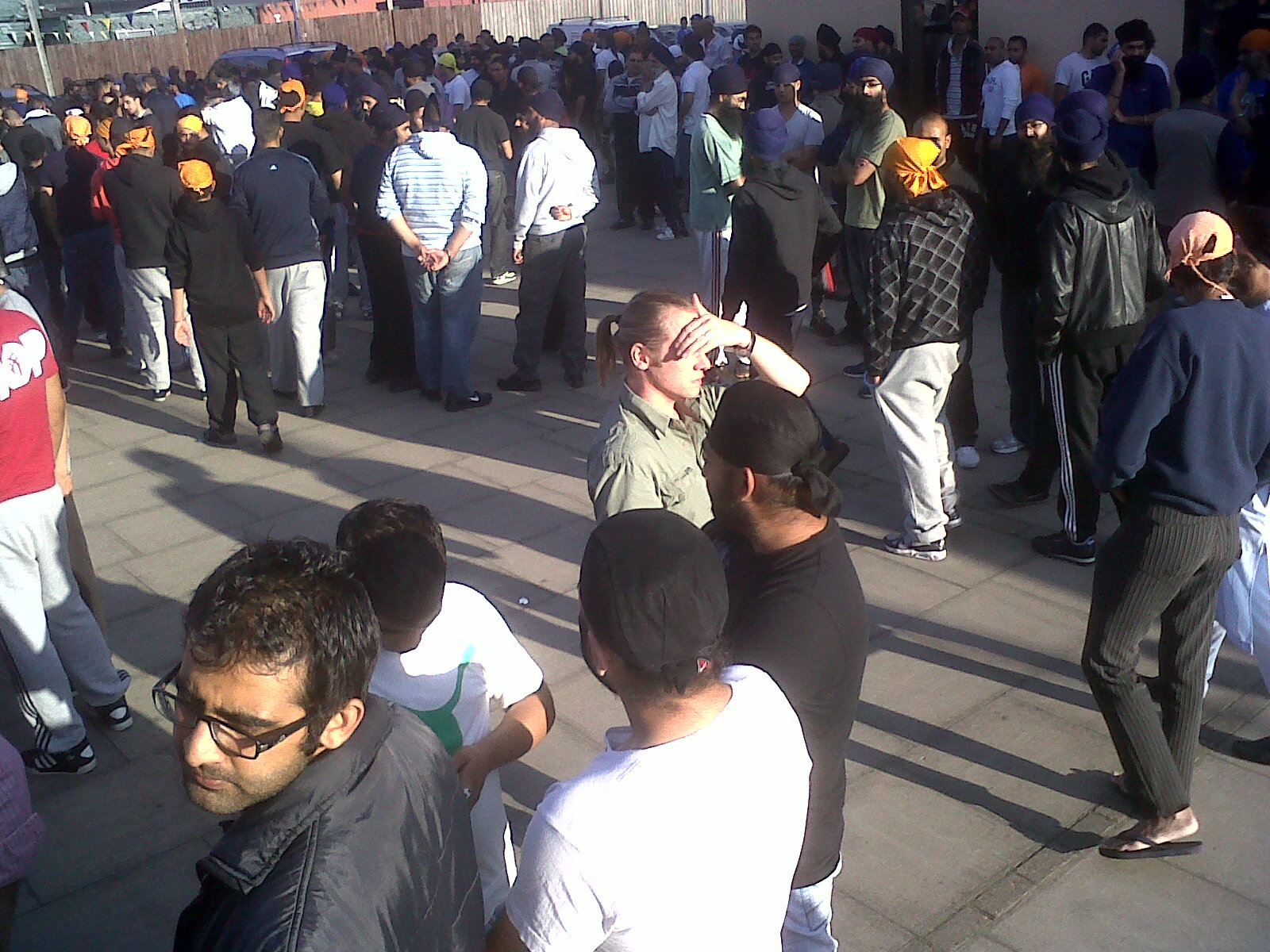 A small number of Sikhs however did not let the thought fall out of sight and continued to monitor the situation. Having realised that a problem may arise, albeit very late at night, they spent the best part of the night driving across London from one Gurdwara to the next to ensure that there was adequate security in place. Where there was not, one man stayed behind or where possible, awoke a local friend to come in. Thus was sewn the seed for a collaborative effort from a number of individuals to coordinate Sikhs that wanted to defend their Gurdware. Throughout Tuesday, Facebook, Twitter and SMS text messages were used to inform and mobilise people into preparing for the night(s) ahead. We at Naujawani also played a small role in coordinating these efforts and garnering support from individuals which personally gave me a greater insight into how things developed over the last 48 hours. It was clear to a few of us that if we were to have any success, people had to be appropriately distributed to different Gurdware. In west London, Southall is naturally the hub and meeting point, but throughout the rioting other Gurdware to the north and east of London were at a higher risk.
A small number of Sikhs however did not let the thought fall out of sight and continued to monitor the situation. Having realised that a problem may arise, albeit very late at night, they spent the best part of the night driving across London from one Gurdwara to the next to ensure that there was adequate security in place. Where there was not, one man stayed behind or where possible, awoke a local friend to come in. Thus was sewn the seed for a collaborative effort from a number of individuals to coordinate Sikhs that wanted to defend their Gurdware. Throughout Tuesday, Facebook, Twitter and SMS text messages were used to inform and mobilise people into preparing for the night(s) ahead. We at Naujawani also played a small role in coordinating these efforts and garnering support from individuals which personally gave me a greater insight into how things developed over the last 48 hours. It was clear to a few of us that if we were to have any success, people had to be appropriately distributed to different Gurdware. In west London, Southall is naturally the hub and meeting point, but throughout the rioting other Gurdware to the north and east of London were at a higher risk.
Guest blogged by Naujawani Sardar
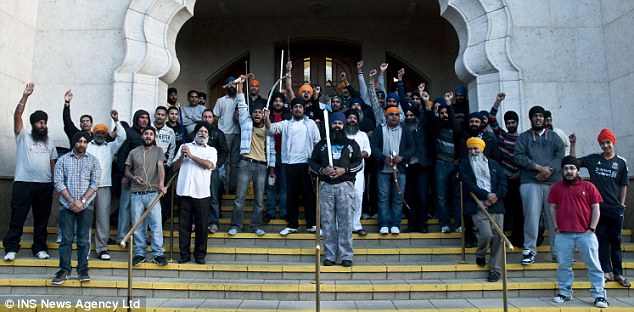 Riots have hit London and a few other cities in the UK over the last three nights causing mayhem, destroying property and leading to looting. Tonight, hundreds of Sikhs are gathering to defend the Gurdware in these cities should they fall under the eye of the looters. It is bringing together Sikhs of all backgrounds and affiliations; promising a glimmer of hope from an otherwise horrible situation.
Riots have hit London and a few other cities in the UK over the last three nights causing mayhem, destroying property and leading to looting. Tonight, hundreds of Sikhs are gathering to defend the Gurdware in these cities should they fall under the eye of the looters. It is bringing together Sikhs of all backgrounds and affiliations; promising a glimmer of hope from an otherwise horrible situation.
To find out more about this mobilisation of Sikhs, go to the Sikh Riot Awareness UK page.
The trigger has been widely recognised as the shooting of a 29 year old black man Mark Duggan in the Tottenham area of North London. 48 hours after his shooting, members of his family, friends and the wider community congregated outside Tottenham Police Station to protest at what they saw as the heavy-handed action of the London Metropolitan Police and the unhelpful communication from them about the matter in the following days. At this gathering of about some 300 protestors, a relatively minor confrontation between a teenager and the Police is said to have ignited running battles that ensued well into the night. A double decker bus was set alight and 49 fires were being dealt with by morning. But more importantly, as a sign of things to come, shops selling household goods, sportswear, toiletries and glasses were looted with CCTV images capturing hooded individuals taking away trollies laden with items.
 The second generation (in N. America) of Sikh organizations are beginning to pool their resources and expand their capabilities. Here I feature 2.
The second generation (in N. America) of Sikh organizations are beginning to pool their resources and expand their capabilities. Here I feature 2.
Seva Food Bank – earlier this summer, Seva Food Bank of Canada welcomed Michael Brito as their part-time Operations Manager. We look forward to hearing about the meaning of the expansion and the exciting growth this service Sikh-based organization is undergoing.
ENSAAF – One of the premier human rights organizations working on issues related to the Sikhs is hiring a Case Summary Writer to draft case summaries based on interviews of families whose loved ones were unlawfully killed or disappeared by India’s security forces. The job description reads:
As the case summaries will ultimately be used in a variety of advocacy initiatives and reports, this is an important position that will offer someone a chance to help mobilize international stakeholders on the issue of impunity for mass state crimes in Punjab, India.
We hope a number of Sikhs decide to apply and promote the goals of this extremely important cause. You can get more information on the ENSAAF website, here. Please read the job description and apply! If not, at least circulate, forward, post on Facebook, tweet on Twitter, and get out the word!
This Monday, Sikhs for Justice is organizing a rally at the United Nations Headquarters to call for UN intervention stop India’s planned execution of Professor Devenderpal Singh Bhullar. Professor Bhullar’s brother, Tejinder Singh Bhullar will be addressing the rally. In their appeal to Secretary General Ban Ki moon, Sikhs for Justice is calling upon the U.N. to intervene and free Professor Bhullar based on a UN General Assembly resolution adopted in 2008 known as Resolution 62/149 which called on all major states to abolish the death penalty. 62/149 is a nonbinding instrument to mark progress on the United Nation’s position that they death penalty undermines human dignity and acknowledges the serious claim that any failure of justice in the implementation of the death penalty is irreversible and irreplaceable.
 The death penalty too, runs contrary to Sikh historical positions on capital punishment. The Sarkar-e-Khalsa of Maharaja Ranjit Singh Ji, followed a no death penalty policy, as M. Gregor in his 1846 ‘History of the Sikhs’ writes. He notes that, ‘[Ranjit Singh] was the exception of Oriental monarchs, and never wantonly inflicted capital punishment and mutilation.’ Other authors describe, that ‘Humanity indeed, or rather a tenderness for life, was a trait in the character of Ranjit Singh. There is no instances of him having wantonly imbued his hands in blood.’ These sentiments that can be seen as consistent Sikh political philosophy captured by the Zafarnama and other documents. Specifically in the Zafarnama, Guru Gobind Singh Ji quotes the Persian poet Firdausi, writing, ‘How nicely the sweet tongued poet Firdausi has said, to act in haste is the work of the devil,’ referring to Aurungzeb’s executions of the youngest Sahibzadas Zorawar and Fateh Singh and Mata Gujri in Sirhind as the act of ‘Sheitan.’
The death penalty too, runs contrary to Sikh historical positions on capital punishment. The Sarkar-e-Khalsa of Maharaja Ranjit Singh Ji, followed a no death penalty policy, as M. Gregor in his 1846 ‘History of the Sikhs’ writes. He notes that, ‘[Ranjit Singh] was the exception of Oriental monarchs, and never wantonly inflicted capital punishment and mutilation.’ Other authors describe, that ‘Humanity indeed, or rather a tenderness for life, was a trait in the character of Ranjit Singh. There is no instances of him having wantonly imbued his hands in blood.’ These sentiments that can be seen as consistent Sikh political philosophy captured by the Zafarnama and other documents. Specifically in the Zafarnama, Guru Gobind Singh Ji quotes the Persian poet Firdausi, writing, ‘How nicely the sweet tongued poet Firdausi has said, to act in haste is the work of the devil,’ referring to Aurungzeb’s executions of the youngest Sahibzadas Zorawar and Fateh Singh and Mata Gujri in Sirhind as the act of ‘Sheitan.’

Amritsar, 1946
I’m going to continue on what appears to be our theme of the week here at TLH — Sikhs and sports. I’m not much of an athlete, though I had a good run of Little League baseball when I was a kid in North Carolina. I remember how goofy I felt wearing my team’s baseball cap over my patka and of course a helmet when I was up to bat. Looking back at the photographs, I looked pretty goofy too.
Fast forward a couple of decades, and I find myself in a related dilemma, though hardly an aesthetic one. This time of year in New York City, my favorite (and most efficient) way to get around is on my bike (the kind that requires pedaling). It’s good exercise, it gets me around Brooklyn and other parts of the city often as quick or quicker than public transit, and it leaves no carbon footprint.
As a dastaar-wearing Sikh, I grapple every day with my decision to ride my bike without a helmet — especially in a place like New York City. I’ve had many friends try to convince me to do otherwise, and I’ve tried many experiments of trying to make a helmet work. After talking to many a bike shop employees, my understanding at the moment is that bike helmets and turbans can’t really co-exist effectively. Even if I were to get an extra large helmet and put it over a small dastaar, it would not protect my skull sufficiently because it would sit too high up.

